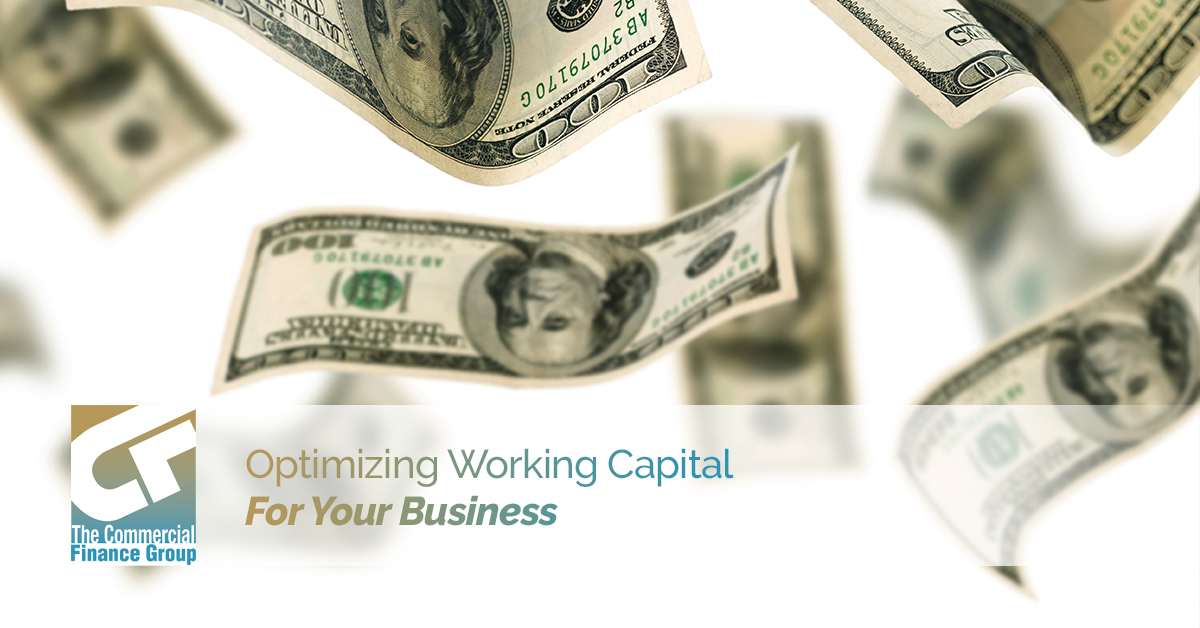If money is power, then this is especially true when it comes to successfully managing, running and growing a small business into the company of your dreams. Now, money is only one aspect of our lives, and while there are countless values and things in life that weigh more importance over money, the reality of our economy and society is that it takes money to make moves and execute business strategies. To really have a successful business, regardless of how great your product or service is, you’ll need to pay close attention to financial matters and make sure that you’re managing things like your cash flow and working capital to your best ability.
The Commercial Finance Group Can Help You Optimize Your Capital
We understand that managing finances may not be your absolute forte as a business owner who’s…well, busy. If you’re seeking additional capital to expand your business in the form of asset-based loans or finance factoring, it might be difficult and even overwhelming to find a solution that you feel comfortable investing your time and efforts in. Amassing a wealth of experience working and growing countless small businesses, The Commercial Finance Group is a reputable, useful and trustworthy financial resource and business capital lender. Through our unique approach to lending your small business the funds you need, you’ll find that financing your business operations wasn’t as difficult, taxing or time-consuming as you once thought it was.
Today’s blog post is focused on useful tips and strategies to get the most out of your working line of credit, making sure that you get the right amount of business credit and use it correctly to invest in the future of your well-earned company. Let’s dive into these working capital tips in hopes that it helps your understanding of your small business finances.
Running Your Day-To-Day Operations
Net working capital is generally understood as the measure of cash or liquid means that a company has available for running its daily operations. Net working capital is important because it represents an essential element for operating a business – by acquiring the appropriate amount of working capital, a company can then determine if it can meet its short-term financial obligations.
Calculating net working capital is actually fairly simple: take your current assets and subtract them by your current liabilities. So, for example, if your current assets total is $70,000 and your current liabilities total $40,000, then your net working capital amounts to $30,000.
Assets and Liabilities
To further clarify, your current assets are either going to be cash or any assets that can immediately be sold for cash like inventory or receivables. Current liabilities, on the other hand, can be defined as anything that costs you money like bills, taxes, debt, and so forth. Whether payment credit is considered an asset or liability depends on who is extending the credit. If suppliers sell to you on credit, then it is considered a liability, but if you extend credit to your customers so that they can buy from you, it would be considered an asset, even if you expect payment soon within the next month or so.
Whether it is actually worthwhile to extend credit to customers or not also depends. If you allow customers to pay on credit (as opposed to paying up front), you need to consider if you will gain more customers and more business, and if so, how much. You’ll also want to consider if this gain will translate into profit greater or less than your total financing cost. If it is more, then yes, it would be worthwhile to sell on credit.
Finding The Right Amount Of Working Capital
Finding the exact amount of working capital that you need for your business can be a tricky matter. You don’t want too little capital because working capital is, of course, require to fund your day to day operations. On the other hand, very low and even negative net working capital is probably not ideal for your business, either. Consider something called the ‘working capital ratio’ to help you assess your working capital condition.
The working capital ratio can be calculated by dividing your current assets by your current liabilities. Ideally, the ratio should be around 2 – if it falls below 2, this could be a sign that you’re having financial problems and that you may be unable to pay off your current liabilities. If it’s above 2, then this could mean you have a poor or inefficient use of capital.
Optimize Your Payables
There are multiple ways to optimize your net working capital, and doing that through payables is one option. In terms of payables, consider contacting your suppliers and vendors and asking them for better payment terms. Go over things like the option to pay over a longer period of time, the option to pay later, if they’re willing to have you buy in volume, or even request a discounted price for up-front payment to them. None of these topics are out of the question, so it doesn’t hurt to try asking about them.
Optimize Your Receivables
Another thing that’s vital to improving and maintaining your working capital is the collection of your accounts receivables. First off, make sure that your payment terms are clear to ensure that money keeps coming in. After you send an invoice, consider calling up the customer to verify that the invoice was actually received. To help optimize your receivables, other options include things like offering discounts to customers for early payments or fines for late payments.
And again, if your cash flow is stagnant in this area, financing may be able to fill the gap.
Optimizing Your Inventory
Monitor your inventory levels very closely and optimize your inventory days, which is the amount of time you store inventory between it being bought by you and then eventually sold to the customer. The more capital you have tied up in your inventory, the more important it is to pay close attention and monitor your inventory.
The main thing to keep in mind with your inventory is to avoid understocking and overstocking. To do this, many companies will use the Just-In-Time (J.I.T.) inventory formula because it is cost-effective and also reduces inventory space, stock-holdings, and the chances of damaged stock. Investing in a specialized inventory tracking or inventory forecasting software is also something worth considering to help automate these inventory management processes for you and your business.
Optimizing Your Loans
When your short-term loans become mature, you should pay them off, or pay them off before they even become mature. Additionally, to optimize your loans, never purchase fixed assets with short-term loans since you can’t convert them quickly back into cash if you need to pay off the loans, as this could negatively affect your working capital.
Your Working Capital Is Worth Your Time
All things considered, the financial supply chain, if not managed efficiently, can be a major pain point in optimizing working capital. Indeed, accounts payable constitutes as the biggest drain in the working capital management of most organizations. In other words, if an organization like your very own small business can manage its cash (including its accounts receivables and accounts payables), it can most likely rein in operating cost.
A healthy cash flow and working capital balance translate into a healthy business, which translates into a healthy you. And don’t we all deserve the best health possible? The Commercial Finance Group believes that we do, and your business deserves the same. We’ve said it once and we’ll say it again, but our core values lie in helping your business grow and achieve the potential that you, as the owner, see in it. So let us help finance your business. Questions about our asset-based lending and working capital solutions through our Burbank, Los Angeles or Atlanta locations? Get in touch with us.








